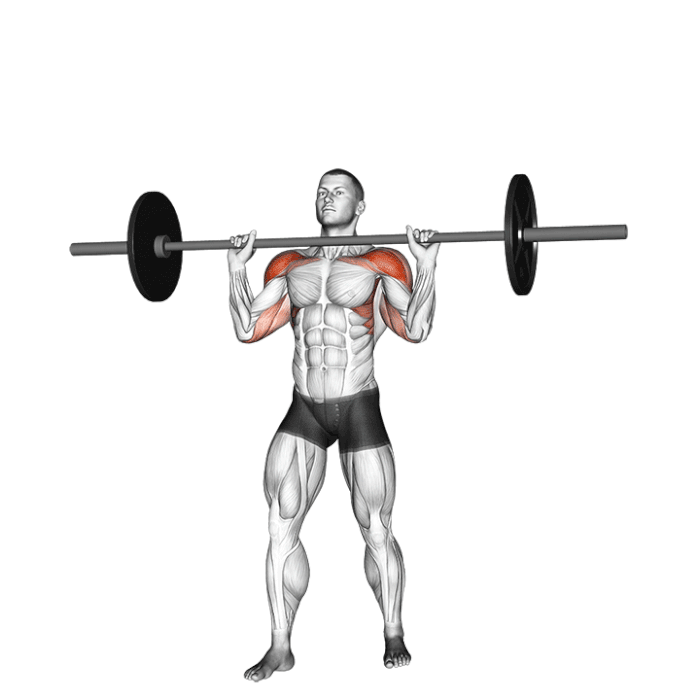Resistance Band Shoulder Press
The Resistance Band Shoulder Press is a versatile and effective exercise that targets the shoulders, allowing for a full range of motion while reducing the strain on your joints. This exercise is an excellent alternative to the traditional dumbbell or barbell shoulder press, particularly for those who prefer a more portable and adaptable form of resistance. Whether you’re training at home, in the gym, or on the go, the Resistance Band Shoulder Press can help you build strength, stability, and endurance in your shoulder muscles.
Targeted Muscle Groups

Primary Muscles:
- Deltoids: The primary muscle group targeted by the Resistance Band Shoulder Press is the deltoids. This exercise focuses on all three heads of the deltoids: anterior (front), lateral (side), and posterior (rear), with an emphasis on the anterior and lateral heads.
Secondary Muscles:
- Triceps Brachii: The triceps play a crucial role in extending the arms during the pressing motion, providing additional power and stability.
- Upper Pectorals: The upper portion of the chest muscles is engaged as a secondary mover, especially when the arms are pressed upward.
- Core Muscles: The abdominals and obliques engage to stabilize your body, helping you maintain balance and posture during the press.
Equipment Needed
- Resistance Band: A durable looped or tube-style resistance band with handles is required. The resistance level can be adjusted based on your strength and fitness level.
- Anchor Point (Optional): The band can be anchored under your feet for added stability or attached to a low, secure point for variation.
How to Perform the Resistance Band Shoulder Press: Step-by-Step Guide
1. Setup:
- Begin by standing with your feet shoulder-width apart. Place the resistance band under your feet, ensuring that it is evenly distributed. Hold the handles or ends of the band with an overhand grip, palms facing forward.

Muscles used in the military press.
Illustration credit © Aliaksandr Makatserchyk
2. Starting Position:
- Stand upright with your core engaged. Bring your hands up to shoulder height, with your elbows bent and close to your body. The resistance band should have some tension, and your wrists should be in line with your forearms.
3. Press the Band Upward:
- Inhale as you begin to press the band upward, extending your arms fully overhead. Keep your elbows slightly bent at the top to maintain tension on the band and avoid locking out your elbows.
4. Top Position:
- At the top of the movement, your arms should be fully extended above your head, with the resistance band providing tension throughout the movement. Hold this position briefly to maximize muscle engagement.
5. Lower the Band:
- Exhale as you slowly lower the band back to the starting position, controlling the movement to maintain resistance. Ensure that your elbows remain close to your body and that the band remains under tension.
6. Repetition:
- Complete the desired number of repetitions, focusing on maintaining proper form and a controlled tempo throughout each rep.
Recommended Reps and Sets
- For Muscle Strength and Hypertrophy: 3-4 sets of 8-12 reps.
- For Endurance and Muscle Tone: 2-3 sets of 12-15 reps.
Rest for 60-90 seconds between sets to allow your muscles to recover while maintaining workout intensity.
Pro Tips for Success
- Engage Your Core: Keep your core tight throughout the exercise to maintain balance and prevent excessive arching of your lower back.
- Focus on Controlled Movement: Avoid using momentum to press the band. Instead, focus on a slow, controlled lift and descent to ensure maximum muscle engagement and to reduce the risk of injury.
- Adjust the Resistance: Choose a resistance band that challenges you without compromising your form. Start with a lighter band and progress to higher resistance as your strength improves.
- Elbow Position: Keep your elbows slightly forward rather than directly to the side. This position engages the deltoids more effectively and reduces stress on the shoulder joints.
Common Mistakes to Avoid
- Leaning Back: Leaning back during the press can put unnecessary strain on your lower back and reduce the effectiveness of the exercise. Keep your core engaged and maintain a neutral spine throughout the movement.
- Inconsistent Tension: Allowing the band to lose tension at any point in the exercise diminishes the benefits. Maintain constant tension by controlling the band’s movement both upward and downward.
- Locking Out Elbows: Fully locking out your elbows at the top of the movement can place stress on the joints. Keep a slight bend in your elbows to maintain tension on the muscles and protect your joints.
- Using Too Heavy Resistance: Choosing a resistance band that’s too heavy can compromise your form and increase the risk of injury. Start with a manageable resistance and gradually increase as your strength improves.
The Resistance Band Shoulder Press is a powerful exercise for developing strong, well-defined shoulders. Its portability and versatility make it an excellent choice for any workout routine, whether you’re training at home or in the gym. By focusing on proper form, controlled movements, and gradually increasing resistance, you can maximize the benefits of this exercise and build robust shoulder strength and stability. Incorporate the Resistance Band Shoulder Press into your upper body routine for a challenging and effective workout.
